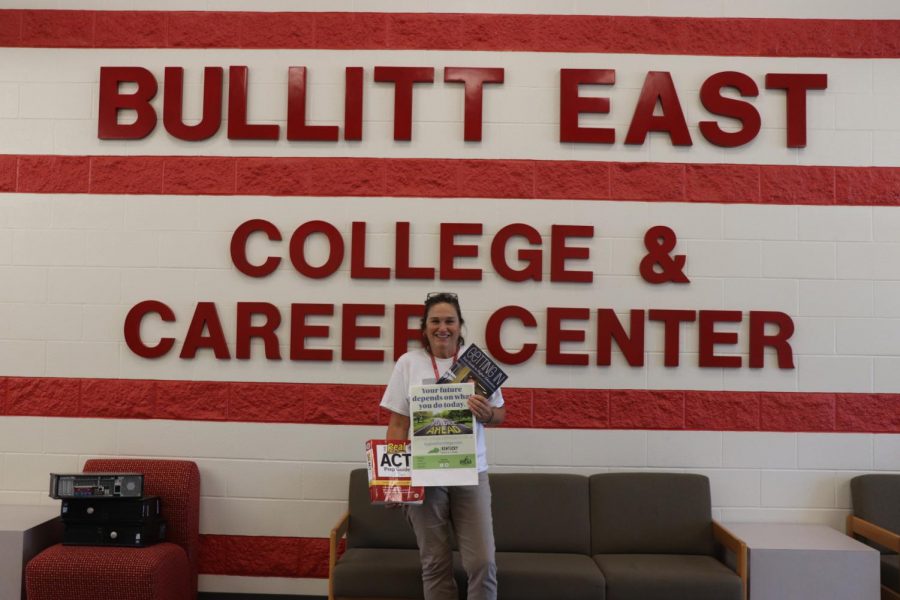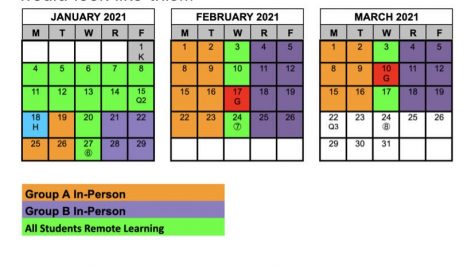Changes Arise in the College and Career Readiness Criteria
Here is Wendy McCutcheon, College and Career Readiness Director at Bullitt East, holding three helpful sources for students to become college- or career-ready or to explore their options regarding their college or career. This program aims to help students prepare for transitioning into whichever postsecondary education or career they choose, withstanding the new changes that have been made in Kentucky for the college and career readiness criteria. “It used to be called college- and career-ready. Now it is academic transition-ready or career transition-ready. Transition meaning that they (the students) have fulfilled or they have demonstrated performance and knowledge that they will be able to transition, either into the workforce or into a postsecondary education,” said McCutcheon.
The standards are changing.
After several years, the standards for becoming college-ready and career-ready have finally changed, providing many new opportunities for students who struggled to meet the old criteria.
To coincide with the terms “college-ready and career-ready ” being renamed “academic transition-ready and career transition-ready,” the KDE (Kentucky Department of Education) has decided to change the guidelines for what makes students eligible for a career or postsecondary education. These recently-revealed changes have already proved to benefit certain students and have been predicted to benefit the student body as a whole once the school year progresses. Because of the new standards for what is considered academic-transition ready and career-transition ready, Bullitt East, and the district overall, are planning to enforce these standards through other new changes as well. Although, some administration members still feel that these standards could be improved.
Prior to when these changes were implemented, the only way students could obtain academic transition readiness was through achieving an ACT (American College Testing) score of 18 in English, 19 in math and 20 in reading. Now, however, a new system for becoming academic transition-ready has been created that prevents students from having to achieve any of these ACT benchmarks.
This system consists of two symbolic buckets, the first representing Quantitative Reasoning or Natural Sciences and the second representing Written or Oral Communications, Arts and Humanities or Social and Behavioral Sciences. For both of these “buckets,” students will have to achieve at least one indicator in order to meet the criteria for academic transition-readiness.
For Quantitative Reasoning or Natural Sciences, the indicators are achieving a 19 on the math portion of the ACT, scoring a B or higher on approved Dual Credit or scoring a three or higher on an AP exam pertaining to one of those subjects. For Written or Oral Communications, Arts and Humanities or Social and Behavioral Sciences, the indicators are achieving a 20 on the reading portion or an 18 on the English portion of the ACT, scoring a B or higher on approved Dual Credit or scoring a three or higher on an AP exam pertaining to one of those subjects.
Although this change was not as recent, students also no longer have the option to take a KYOTE (Kentucky Online Testing) placement test to substitute for them not meeting an ACT benchmark in order to become academic transition-ready. The college or university students plan to go to will most likely exempt them from having to take a remediation class for that subject if they pass the ACT, but schools in the state will not accept this as an alternative to not meeting ACT benchmarks anymore. These changes have been made due to the old criteria not demonstrating that students were fully prepared to enter the workforce or college.
“…Academic transition-ready has become easier…So now there’s only two buckets, so-to-speak, that you have to fill. In the past, it basically would’ve been three buckets,” said Wendy McCutcheon, College and Career Readiness Director at Bullitt East.
For becoming career transition-ready, not many major changes have been made, but these changes are intended to prepare students much more effectively for whatever career they’re planning on pursuing. The indicators for career transition readiness are now that students have to either meet benchmarks on an Industry Certification Test, score at or above the benchmark on the Career and Technical Education End-of-Program Assessment for articulated credit, earn a grade of B or higher in each course on six or more hours of KDE-approved Career and Technical dual credit, complete a KDE Labor Cabinet approved apprenticeship or complete a KDE-approved alternate process to verify exceptional work experience. Out of these indicators, the only new ones are that students have to meet the benchmarks on an Industry Certification Test or End-of-Program Assessment for the career pathway they have completed.
“…Career pathways now either have an industry certificate or End-of-Program assessment at the end of each pathway. When students obtain these, it really does help them in their future lives,” said Lee Barger, College and Career Readiness Director for Bullitt County.
With many students struggling to meet ACT benchmarks for academic transition readiness, they now have two other options that prevent them from having to invest so much time and money to meet those benchmarks. The main struggle for students has proven to be achieving the math ACT benchmark of 19, but now those students who have failed to achieve that benchmark can try taking a dual credit or AP class to meet the Quantitative Reasoning or Natural Sciences requirements if they choose to do so. Taking those classes would prepare them for the college set-up and workload in that the content of those classes is based on college-level curriculums. Both types of classes also give you the opportunity to earn college credit.
With the KYOTE test no longer being an option for students to achieve academic transition readiness for lack of meeting ACT benchmarks, students could resort to taking dual credit or AP classes in order to meet the benchmarks. But later on, they will either have to take a remediation class in college or a KYOTE test provided by their college to avoid taking that class. Overall, these changes should invoke a positive reaction in students since they now have more options for becoming academic transition-ready. Graduating classes of the past at Bullitt East tend to only have five to twenty students who are not academic transition or career transition-ready, and even these students have the opportunity to overcome this through a petition process, and used-to-be passing a KYOTE test.
“Students have a variety of ways to earn college and career readiness. I’m a huge fan of the additions of Arts and Humanities AP and dual credit. Arts and humanities are very important, and we have numerous students that really enjoy them,” said Barger.
One student in particular, senior Tyler Steinmetz, has already benefited from these changes without having to take any extra steps to achieve academic transition or career transition readiness like other students may have to. Before these changes were enforced, Steinmetz was doing all the necessary ACT preparation to earn the previously required ACT reading benchmark since he already earned the math and English benchmarks. But once it was established that he could either meet the reading or English ACT benchmark instead of both to be academic transition-ready, he then automatically met all the components for being academic-transition ready. He no longer has to do any extra studying to try to increase his ACT reading score, unless he wants to, because he is now eligible to graduate.
“I think it’s awesome because before they made those rules, the only way you could be college-ready was the ACT. And I thought that was ridiculous because for one, we don’t even study for the ACT in school. We study for individual tests and stuff along those lines, so when we go into the ACT room we’re completely blindsided by whatever might be on the test. So I think giving us credit for doing well in class is awesome because we’ve never had that before,” said Steinmetz.
Although McCutcheon recognizes that academic transition readiness is now easier for students to achieve, she doesn’t think it will truly prepare students for college. For example, although receiving a score of 19 on the ACT math portion would indicate that you have filled the Quantitative Reasoning or Natural Sciences bucket, you would still be required to take a math remediation class in college for any score lower than a 22. Although someone may be academic transition-ready by definition, they’re not fully prepared to attend college until they have mastered that college-level material. Therefore, McCutcheon encourages those who have already met the academic transition readiness ACT components but are still lacking in one ACT subject to continue taking the ACT until they earn the college-recommended score and to stay in classes in high school necessary for that. “They (schools in Kentucky) should still ask for what the college asks for. I want students to be ready to go to college, so I think them lessening the components is not necessarily best for the students. We should still have the high expectations,” said McCutcheon.
In terms of changes Bullitt East has made to accomodate for the new academic transition-ready and career transition-ready standards, it is now following the KDE’s new guidelines for accountability. Administration members are also currently in the process of educating students and parents of these changes as all the teachers have been informed of the changes so far. McCutcheon is also trying to advertise these changes through creative ways, such as with her idea for seniors to write their name on a ball and shoot it into a bucket once they’ve become academic transition-ready or career transition-ready. These buckets are also going to be used for the administration to demonstrate the changes the KDE has made.
For Bullitt County, Barger plans to expand some of the dual credit in Career and Technical education classes by working with some of his postsecondary partners. As with Bullitt East focusing on informing people of the changes, Barger is in the process of meeting with each of the 26 schools in the district for this purpose. His leadership team plans to continue helping students in grades K-12 on achieving transition readiness, including working with each level to ensure that students are meeting the criteria and providing resources for them if they aren’t.
The graduation policy will also change soon, as the district is currently waiting on graduation requirements to be approved by the KDE. The petition process that students can endure if they don’t achieve transition readiness is now being revisited by the Bullitt County Board of Education, so there may be changes to that by the end of this school year as well. Overall, the district wants to ensure that students are preparing for the ACT, exploring AP and dual credit options and are placed in pathways that they are interested in and that lead to jobs in our community. Ensuring these things will help resolve the challenges that schools in our district face with becoming transition-ready.
“I love the new changes. I think it not only places value on the ACT, but it places value on AP testing and dual credit for academic transition readiness. I also love the new changes with career readiness. My hope is that this new change will encourage all students to attend some type of postsecondary education. I love the emphasis on Career and Technical Education and making dual credit in it important,” said Barger.









